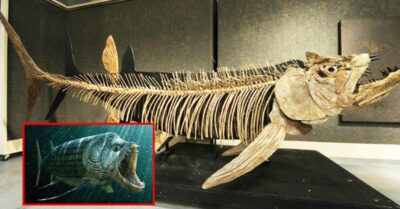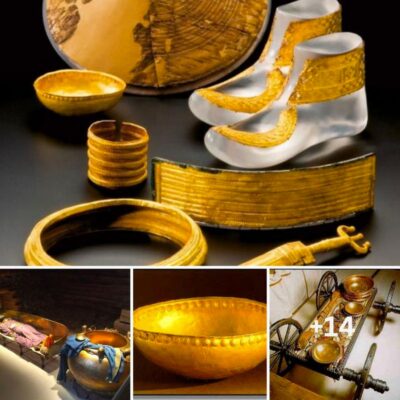Do you ever dream of discovering hidden treasures worth millions while embarking on an exciting adventure? These incredible stories of amateur treasure hunters, metal detectors in hand, and unearthing valuable hoards will surely pique your curiosity and perhaps inspire you to take up the hobby yourself. Join us as we explore some of the most valuable and historically significant treasure troves ever found.

Staffordshire Hoard. Source: David Rowan/Wikimedia Commons
1. Staffordshire Hoard, 2009
In 2009, Terry Herbert, a passionate amateur treasure hunter, was exploring a plowed field near Hammerwich, Staffordshire, England, when his metal detector signaled a significant discovery. Over five days of diligent excavation, Herbert and the landowner, Fred Johnson, unearthed a staggering 3,500 military artifacts, collectively known as the Staffordshire Hoard. This extraordinary find included over 11 pounds of gold, 3 pounds of silver, and semi-precious garnets, possibly sourced from as far as Sri Lanka or Afghanistan. Dating back to the 6th and 7th centuries, during the Anglo-Saxon kingdom of Mercia, the hoard is believed to have been buried around 875 A.D., when the region was under Viking threat. Today, these treasures are displayed at the Birmingham Museum, enriching our understanding of this historical period.

2. The Le Catillon II Hoard, 2012
Reg Mead and Richard Miles, metal detection enthusiasts from Jersey, embarked on a decades-long quest after hearing a farmer’s tale in the early 1980s. The farmer claimed to have discovered silver coins while plowing his field on the British island of Jersey. Mead and Miles, armed with perseverance, obtained permission to search the field for a mere 10 to 15 hours each year after the harvest. Their dedication bore fruit in 2012 when they unearthed 68,000 coins, along with gold neck torcs and glass beads. These treasures, dating back to 30 B.C. to 40 B.C., were buried by the Coriosolitae tribe of Celts, likely fleeing from a Roman invasion led by Julius Caesar. The Le Catillon II Hoard stands as the largest collection of gold jewelry and Celtic coins ever found.

Roman Solidi. Source: Panairjdde/Wikimedia Commons
3. St. Albans Hoard, 2012
In 2012, novice metal detectorist Westley Carrington ventured into a farm field in Berkhamsted, England, armed with a beginner’s metal detector. His discovery turned out to be one of the largest hoards of Roman gold coins ever uncovered in Great Britain—159 Roman Solidi from the late fourth century A.D., marking the end of Roman rule in Britain. These coins, far more valuable than typical Roman currency, provide valuable insights into this historical era. Displayed at the Verulamium Museum, they serve as a testament to Roman influence in the region.

Hoxne Hoard. Source: Mike Peel/Wikimedia Commons
4. Hoxne Hoard, 1992
In 1992, a lost hammer led to an astonishing discovery in a farm field near Hoxne, Suffolk, England. Eric Lawes, who was asked to find the missing tool with his metal detector, stumbled upon a trove of silver spoons, gold jewelry, and gold and silver coins instead. This chance find revealed the largest collection of late Roman gold and silver in Britain, comprising 569 gold coins (solidi), 14,272 silver coins, and various other items. Valued at £1.75 million in 1993, the Hoxne Hoard is now on display at the British Museum.

Cuerdale Hoard. Source: JMiall/Wikimedia Commons
5. The Cuerdale Hoard, 1840
In 1840, workers repairing the River Ribble embankment near Cuerdale, England, unearthed a lead box containing one of the largest Viking hoards ever discovered. This remarkable find, known as the Cuerdale Hoard, contained over 8,600 items, including silver coins, jewelry, and silver ingots. Some items even originated from as far as Scandinavia, Italy, and Byzantium. Buried between 903 A.D. and 910 A.D., this treasure offers a glimpse into Viking history and is displayed at the British Museum.

Sroda crown. Source: Tlumaczek/Wikimedia Commons
6. Środa Treasure, 1885–1888
In 1885, workers demolishing a building in Środa Śląska, Poland, stumbled upon a vase containing over 3,000 silver coins dating to the 14th century. As they continued demolishing nearby buildings, more silver and gold coins emerged. The treasure included a gold woman’s crown, gold pendants, a medieval gold clasp, and a sapphire ring. Believed to have belonged to Emperor Charles IV, this treasure reflects a fascinating chapter of European history. It is displayed at the Regional Museum in Środa Śląska, with ownership held by the National Museum in Wrocław, Poland.

7. Caesarea Sunken Treasure, 2015
In 2015, after a violent storm along Israel’s Mediterranean coastline, scuba diver Zvika Fayer discovered a seabed scattered with gold dinars. These coins, minted during the reigns of Caliphs al-Hakim and al-Zahir, date to the time of the Islamic Fatimid Dynasty, just before the First Crusade in 1095 A.D. Caesarea’s rich history, from Phoenician and Greek trading posts to Roman and Herodian rule, provides an incredible backdrop to this priceless treasure.

Panagyurishte Hoard. Source: Ann Wuyts/Flickr/Wikimedia Commons
8. The Panagyurishte Treasure, 1949
In 1949, three brothers searching for clay at a tile factory near Panagyurishte, Bulgaria, stumbled upon an astonishing find. Among the objects was a solid gold ceremonial drinking horn from the 4th century B.C., alongside golden decanters, dishes, and vases. Weighing 13 pounds in total, these items provide a window into Thracian history, potentially hidden to protect them from Celtic or Macedonian invasions. The Panagyurishte Treasure is displayed at the Plovdiv Regional Historical Museum.

Saddle Ridge Hoard $10 gold coin. Source: Kagin’s Inc./Wikimedia Commons
9. The Saddle Ridge Hoard (2013)
In 2013, a Northern California couple walking their dog on their property made a startling discovery—a rusty can filled with gold coins. The couple unearthed eight cans, containing a total of 1,427 gold coins dating from 1847 to 1894. Some of these coins were in uncirculated mint condition and were among the finest specimens of their kind. This remarkable find has raised questions about its origin, with some speculating it might be linked to a theft from the U.S. Mint.

10. Bactrian Gold, 1978
In 1978, a Soviet-Afghan archaeological team led by Viktor Sarianidi was excavating at Tillya Tepe in Afghanistan. They unearthed an astounding 20,600 items, including coins, gold, silver, ivory, and precious stones dating between 100 B.C. and 100 A.D. Among the











